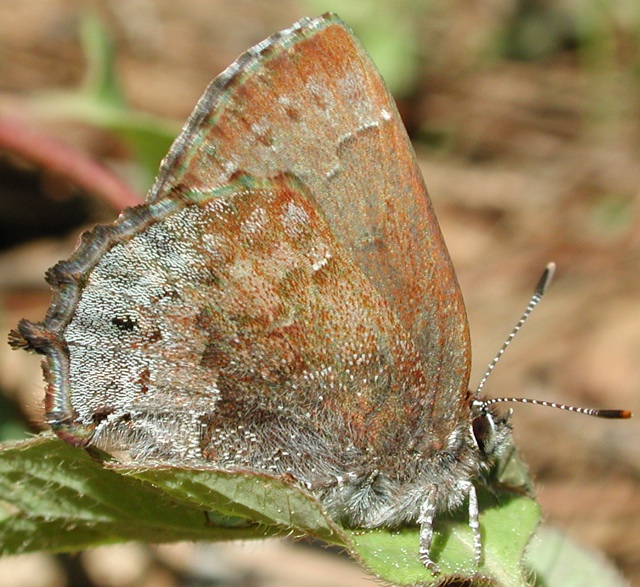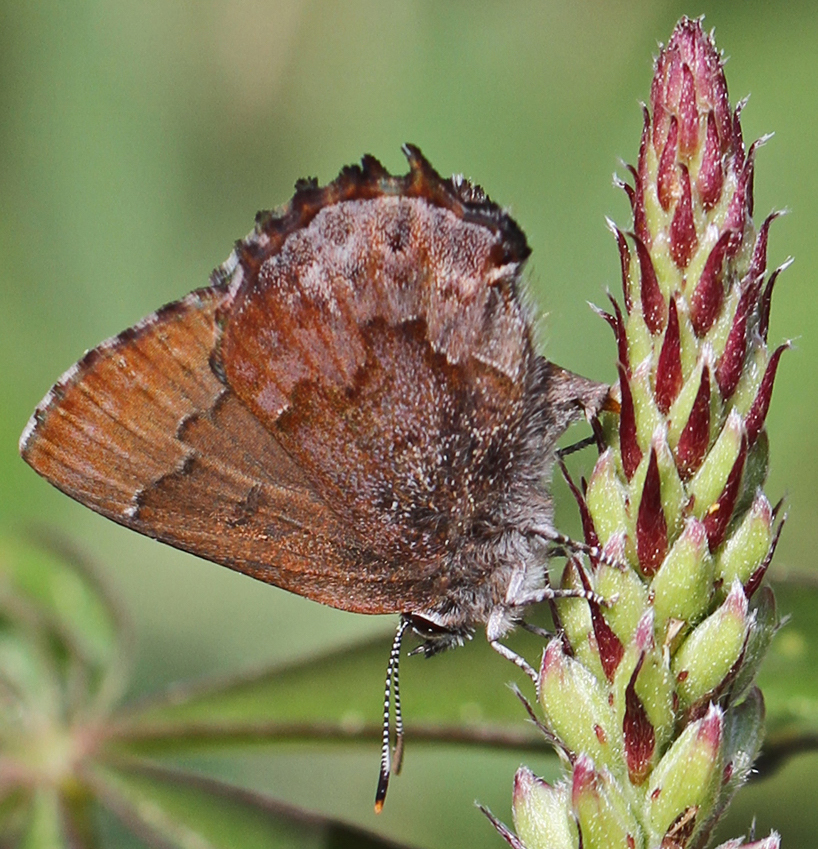|
| Common Name | Frosted Elfin by Scott Hartley => Weymouth Woods-SNP, 2006-04-20, ovipositing on lupine
[View PDF]
 Click to enlarge Click to enlarge
[Google Images] GBIF [Global Distribution ] BoA [Images ] iNaturalist |
| Scientific Name | Callophrys irus
|
| Link to BAMONA species account. |
| Map | Click on a county for list of all database records for the species in that county.
 |
| Distribution | DISTRIBUTION: Scattered in the southern half of the Coastal Plain (including the Sandhills); currently known elsewhere at just a few sites in the northern Coastal Plain (Chowan and Gates counties), in the eastern Piedmont (Franklin County), and in the southern Mountains (Cherokee and Swain counties). Formerly present more widely in the southern Mountains/foothills. No records for the northern Mountains, essentially all of the Piedmont, and the northwestern Coastal Plain.
|
| Abundance | ABUNDANCE: Rare to very rare in the southern half of the Coastal Plain; more widespread in the Sandhills than elsewhere, but even there it is rare. It is extremely rare in the northern Coastal Plain, the eastern Piedmont, and the southern Mountains. The species has declined in NC (and across the Eastern United States) in recent decades and is now one of the rarest butterflies (that has a sizable range) in the state.
|
| Flight | FLIGHT PERIOD: A single brood; in the Coastal Plain mainly during the last 20 days of April, with a handful of records in May. The Franklin County records are for mid- and late April; probably late April to mid-May in the Mountains, though there are very old collections in late June and early July. The flight is later than Brown or Henry's elfins, where they occur with Frosted Elfin. This species has a remarkably narrow flight period, seemingly only two to three weeks long in the Sandhills.
|
| Habitat | HABITAT: Restricted to areas with lupines (Lupinus spp.) or wild indigos (Baptisia spp.). These are typically along edges of upland or xeric woods. Plants of these genera are usually found along edges of woods or in clearings, or within open woodlands. Blue Sandhill Lupine (Lupinus diffusus) is locally common in open stands of Longleaf Pine/scrub oak woods in the Sandhills.
|
| Plants | FOOD AND NECTAR PLANTS: Foodplants are Lupinus or Baptisia; Yellow Wild Indigo (Baptisia tinctoria) only in the Piedmont and Mountains. Females lay eggs on unopened flowers of these plants; thus, you should carefully scrutinize the inflorescences of these plants for the butterflies. Nectar plants are not well known in NC, but lupines bloom in April and are used, along with blueberries (Vaccinium spp.).
|
| Comments | COMMENTS: Because this species has such restricted foodplants, it can be purposefully searched for. However, suitable habitat is relatively rare, except in the Sandhills, where Blue Sandhill Lupine and Gray-hairy Wild Indigo (Baptisia cinerea) are locally common. It is in this region where one has the best chance of finding this species, especially by walking or slowly driving and looking for the sky-blue colors of the lupine in bloom. A new population was found in 2006 in Harnett County; the site lies in the Coastal Plain, but outside the Sandhills. The state's largest known population is near the coast in Holly Shelter Game Land in Pender County, where an excellent one-day tally of 30 individuals was made on April 15, 2012; an even better tally of 34 elfins was made there on April 15, 2014. Sadly, this population has crashed in the past few years, perhaps owing to lack of fire in the pine stands and thus woody plants have gotten so dense they have shaded out the wild indigo foodplants.
I discovered a colony in Franklin County in April 2002, in a powerline clearing with an abundance of Yellow Wild Indigo, its foodplant at the site. This was a first record for the Piedmont outside of the foothills. Powerline clearings are common in the eastern Piedmont, and many have been worked in late April (for species such as Cobweb or Dusted skippers). In all likelihood, few powerlines have sufficient populations of wild indigo to support the Frosted Elfin. Floyd and Signa Williams, and Larry Lynch, have found a colony on a sand ridge in Gates County in 2014 and 2015; there is an old record from this county. This sand ridge continues south into Chowan County, where one was photographed in 2023. Remarkable was one photographed in Swain County in the Mountains on April 17, 2019, by Tom Howe (photo on the Butterflies and Moths of North America website); the three photos were scrutinized by numerous reviewers, with consensus that it indeed was corrected identified. Two others have been photographed in 2018 and 2020 in somewhat nearby Cherokee County. Thus, there must certainly be a few other undiscovered locales in the lower elevations of the southern Mountains.
|
State Rank | S2 | | State Status | SR |
Global Rank | G2G3 | | Federal Status | |
| Synonym | Incisalia irus
|
| Other Name |
|
|
|

 >>
>>

